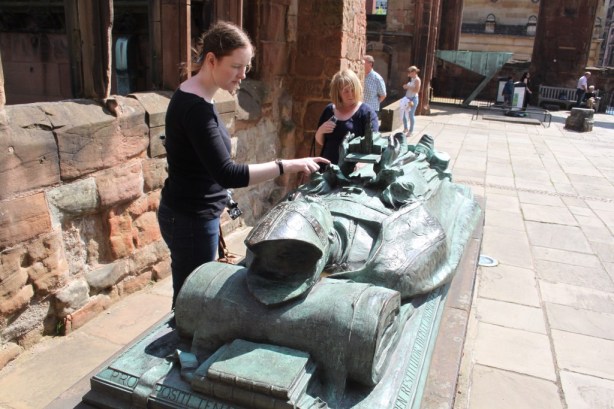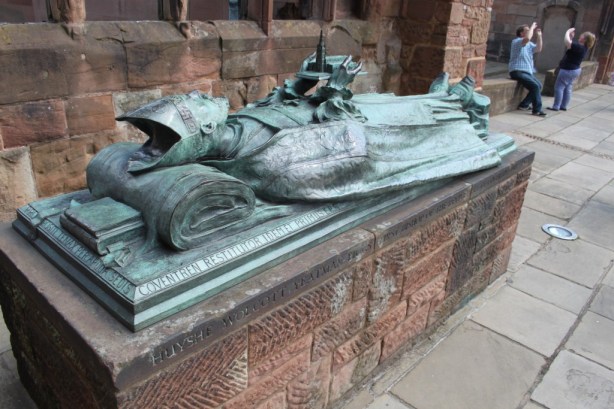
Bishop Yeatman-Biggs’ effigy tomb, set in the open-air ruins of St Michael’s cathedral church, Coventry
This entry from Howard’s Archaeodeath blog relates to his earlier blog about effigy tombs in cathedrals and another about Coventry Cathedral. It concerns the amazing survival of the effigy tomb of the excitingly named Bishop Huyshe Wolcott Yeatman-Biggs (1845-1922).

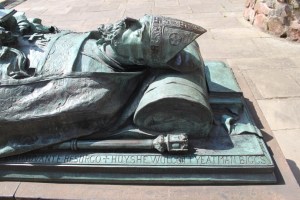 Situated within the ruins of St Michael’s cathedral church Coventry, this is a striking example of an early 20th-century bronze effigy tomb with an inherent textual and material biography to it for all to see, charting its passage from its construction to the present day. This was the only tomb to survive nearly intact following the cathedral’s bombing in 1940 and so its significance speaks of its original subject, the bombing and the aftermath of the ruin as a symbol of Coventry’s identity and a powerful memorial environment.
Situated within the ruins of St Michael’s cathedral church Coventry, this is a striking example of an early 20th-century bronze effigy tomb with an inherent textual and material biography to it for all to see, charting its passage from its construction to the present day. This was the only tomb to survive nearly intact following the cathedral’s bombing in 1940 and so its significance speaks of its original subject, the bombing and the aftermath of the ruin as a symbol of Coventry’s identity and a powerful memorial environment.
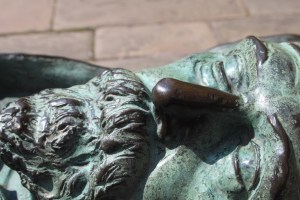
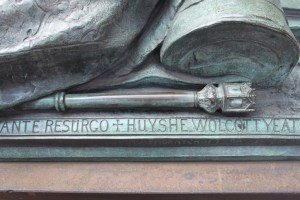 This kind of episcopal effigy tomb – in stone or metal – is the last-gasp of a long tradition of tombs depicting life-size supine bodies posed in prayer which began in the Middle Ages and has been transformed and adapted for over 700 years. In other words, it is a hyper-conservative piece of medievalism. To use a bipedal carnivorous dinosaur analogy (and why not?), this Coventry Cathedral effigy tomb might be regarded as the Tyrannosaurus Rex of effigy tombs in two senses. First, it is among the youngest in the material record and is devastatingly honed to its task (although the hands are well-proportioned: in that regard the T-Rex analogy doesn’t really work…). Second, like a big meat-eating dinosaur, it has proved to be remarkably efficient and tenacious: German bombing failed to destroy it, so perhaps only a future asteroid will dispatch it once and for all…
This kind of episcopal effigy tomb – in stone or metal – is the last-gasp of a long tradition of tombs depicting life-size supine bodies posed in prayer which began in the Middle Ages and has been transformed and adapted for over 700 years. In other words, it is a hyper-conservative piece of medievalism. To use a bipedal carnivorous dinosaur analogy (and why not?), this Coventry Cathedral effigy tomb might be regarded as the Tyrannosaurus Rex of effigy tombs in two senses. First, it is among the youngest in the material record and is devastatingly honed to its task (although the hands are well-proportioned: in that regard the T-Rex analogy doesn’t really work…). Second, like a big meat-eating dinosaur, it has proved to be remarkably efficient and tenacious: German bombing failed to destroy it, so perhaps only a future asteroid will dispatch it once and for all…
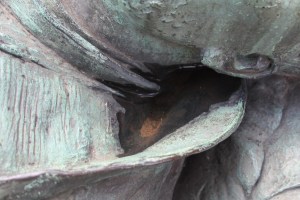
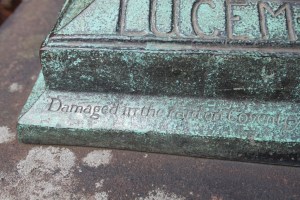 So this is a memorial dinosaur that refused to become extinct and it endures to the present.
So this is a memorial dinosaur that refused to become extinct and it endures to the present.
The form is strikingly realistic, with books, his staff, episcopal robes and the symbol of the church itself in his hands, all denoting his rank as a bishop. There are three texts, the original in Latin set into the bronze, the second is smaller and inscribed in italic English text, and the third is in large Roman capitals and again in English and inscribed into the stone base. Together they tell the story of a monument constructed to commemorate the first Bishop (Yeatman-Biggs) of the restored episcopal see of Coventry established at St Michael’s church, its damage by the bombing of 1940 and its restoration in 1951.

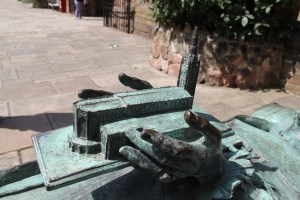 Of course this monument was never designed for an open-air setting, and its materiality is also fascinating. Of particular interest to my PhD student – Ruth Nugent – is the traces of haptic engagement with the monument by visitors – the fingers, parts of the mitre and face (including the prominent swastika motif that subsequent becomes incongruous given the fate of the cathedral), the church in his hands and tops of the toes of his shoes. Also of interest are the areas where the water collects after rain – given a striking sense of a monument exposed to unexpected elements.
Of course this monument was never designed for an open-air setting, and its materiality is also fascinating. Of particular interest to my PhD student – Ruth Nugent – is the traces of haptic engagement with the monument by visitors – the fingers, parts of the mitre and face (including the prominent swastika motif that subsequent becomes incongruous given the fate of the cathedral), the church in his hands and tops of the toes of his shoes. Also of interest are the areas where the water collects after rain – given a striking sense of a monument exposed to unexpected elements.
In summary, this is an effigy tomb with its commemorative significance has accrued and is written onto it with texts and wear: a true dinosaur in its retrospective form and its tenaciousness against all adversities.

